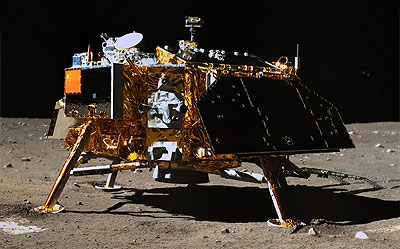Thank you very much for visiting Gunter's Space Page. I hope that this site is useful and informative for you.
If you appreciate the information provided on this site, please consider supporting my work by making a simple and secure donation via PayPal. Please help to run the website and keep everything free of charge. Thank you very much.
Chang'e 3, 4 (CE 3, 4) / Yutu 1, 2

Chang'e 3 lander [NAOC]

Yutu rover [NAOC]
Chang'e 3 is China's first lunar lander project, which consists of a lander module, which will deploy the solar powered Yutu rover on the lunar surface.
The lander is powered by solar arrays, augmented by a RTG (Radioisotope Thermoelectric Generator) to provide power during the lunar nights. The lander has a mass of 1200 kg and has a scientific payload of seven instruments and cameras. One of the paylaods is an astronomical telescope, comprising an EUV (extreme ultraviolet) camera, to investigate, how solar activity affects the ion layer near the Earth. This makes Chang'e 3 the world's first lunar-based astronomical observatory.
The 120 kg rover, named Yutu, is deployed after landing from the lander to explore areas surrounding the landing spot. It is powered by solar arrays, which allow operation during the lunar day. During the night, it remains inactive and is heated by a RHU (Radioactive Heater Unit). It carries a 20 kg payload consisting of panoramic cameras for live viedeo and two spectrometers, one operating in the infrared, the other using alpha particles and X-rays. Also it carries a ground penetrating radar to inspect the composition of the soil and the structure of the crust beneath it.
A CZ-3B/G2 vehicle launched the Chang'e 3 mission in 2013 from Xichang. It landed on 15 December 2013 at the Sinus Iridum basaltic lava plain, that forms a northwestern extension to the Mare Imbrium. The Yutu rover was deployed, but suffered a mechanical control abnormality and failed to move after hibernating for its first 14-day night spent on the Moon. Yutu managed to operate from a stationary position for over two years, contributing to the science goals of the mission.
A similar second rover mission called Chang'e 4 is planned to land on the lunar far side in 2018, deploy the Yutu 2 and is to communicate via the Queqiao 1 (Chang'e 4 Relay) satellite.
The Chang'e 4 lander carries following payloads:
- Topography camera for optical imaging of the landing area to investigate surface morphology and geological structure
- Landing camera for optical imaging of the landing area during descent to investigate surface morphology and geological structure
- Low-frequency radio frequency spectrum analyser for detection of low-frequency radio frequency characteristics of the sun and the moon's low-frequency radio environment to perform low-frequency radio astronomy observations
- Lunar neutron and radiation dose detector (LND, Germany) and neutral atomic detector (ASAN, Sweden) for detection of lunar surface particle radiation and its dose to investigate landing site particle radiation environment
The Chang'e 4 rover Yutu 2 hosts following payloads:
- Panoramic camera to obtain three-dimensional images of the landing and patrolling lunar surface for investiation of surface morphology and geological structure
- Moon radar for surveying the lunar sub-surface structure to investigate surface morphology and geological structure
- Infrared imaging spectrometer for patrol area lunar surface infrared spectroscopy and imaging exploration to survey lunar surface material composition and available resources
- Lunar neutron and radiation dose detector (LND, Germany) neutral atomic detector (ASAN, Sweden) for observations of energy-neutral atoms and positive ions in patrol area to investigate the particle radiation environment in patrol area
| Nation: | China |
|---|---|
| Type / Application: | Lunar lander and rover |
| Operator: | CNSA |
| Contractors: | CAST |
| Equipment: | |
| Configuration: | |
| Propulsion: | ? |
| Power: | 2 deployable solar arrays, RTG, batteries (lander); 2 deployable solar arrays, batteries (rover) |
| Lifetime: | |
| Mass: | 3780 kg (launch); 1200 kg (lander); 120 kg (rover) |
| Orbit: | interplanetary, lunar orbit |
| Satellite | COSPAR | Date | LS | Launch Vehicle | Remarks | |
|---|---|---|---|---|---|---|
| Chang'e 3 (CE 3) | 2013-070A | 01.12.2013 | Xi LC-2 | CZ-3B/G2 | ||
| Chang'e 4 (CE 4) | 2018-103A | 07.12.2018 | Xi LC-2 | CZ-3B/G2 |
References:
- CAST Website
